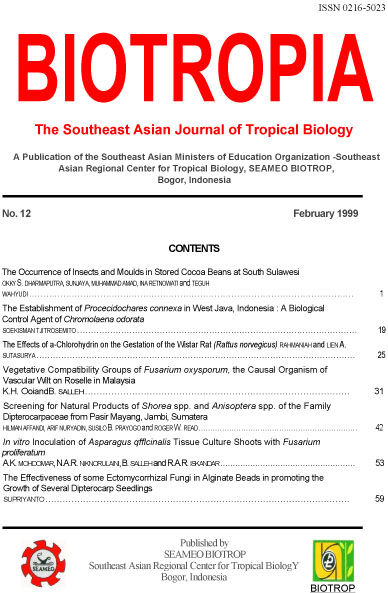
Tags
THE OCCURRENCE OF INSECTS AND MOULDS IN STORED COCOA BEANS AT SOUTH SULAWESI
Content Language : English

Surveys on postharvest handling and technology processing of cocoa beans at farmer, trader and
exporter levels in South Sulawesi were conducted together with investigations on moisture content, pest
infestation (insect and mould) and quality characteristics in terms of reducing sugar, free amino acid and
free fatty acid content.
Surveys were conducted during dry (July 1997) and wet seasons (February 1998) in three regencies
(Pinrang, Polewali-Mamasa and Luwu) and Ujung Pandang, South Sulawesi province. Interviews were
carried out during surveys in the dry season. Number of respondents from farmers, trailers and exporters
was 38, 15 and 5, respectively. In each season, number of samples taken from farmers, traders and exporters
was 9, 21 and 15, respectively. In general, farmers, traders and exporters did not carry out postharvest
handling and technology processing properly. Moisture content of cocoa beans collected from farmers,
traders and exporters were higher than the tolerable limit recommended by SNI (7.5%). Moisture content of
cocoa beans collected during the wet season was higher than in the dry season.
Insects were found on cocoa beans collected from traders and exporters. Species composition and the
presence of each insect species were varied among the two seasons, but the predominant species was
Tribolium castaneum. At trader level the percentage of insect-damaged beans during the wet season was
higher than that during the dry season, while at exporter level it was lower.
During the two seasons the percentage of mouldy beans at farmer level was lower than the tolerable
limit recommended by SNI (4%), while those from some samples at trader and exporter levels
were higher than 4%, but based on the direct plating method, all of the samples at trader and exporter
levels were mouldy.
Species composition and the percentage of beans infected by each mould species at farmer, trader
and exporter levels during the two seasons were varied. The percentage of mouldy beans increased at
trader and exporter levels. The predominant moulds were Aspergillus flaws, Eurotium amstelodami, E.
chevalieri and Penicillium citrinum. The predominant mould at farmer level during wet season was
Saccharomyces cerevisiae (yeast).
Reducing sugar and free amino acid content of cocoa beans collected during the dry season was
higher than those collected during the wet season, either at farmer, trader or exporter levels. Free fatty
acid content of cocoa beans tends to be higher during the wet season than the dry season at the three
levels.

This work is licensed under a Creative Commons Attribution-NonCommercial-NoDerivatives 4.0 International License.
